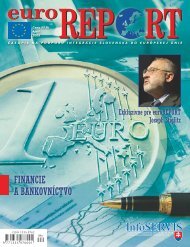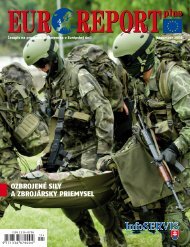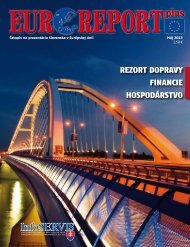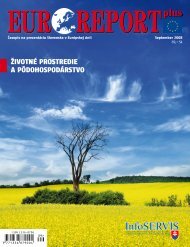Otvoriť - EUROREPORT plus
Otvoriť - EUROREPORT plus
Otvoriť - EUROREPORT plus
- No tags were found...
Create successful ePaper yourself
Turn your PDF publications into a flip-book with our unique Google optimized e-Paper software.
SummarySUMMARYExcerpt from an Interviewwith Mr. Dušan Čaplovič, the DeputyPrime Minister■ The final proposal of the NationalStrategic Reference Frame was developedat the extraordinary governmental sessionon 8 October 2006 what has been treatedimmediately by some oppositional politiciansand mass media as a fight of the SMER -Social Democracy for a decisive position indistributing the resources from the EuropeanUnion funds. Is there any other explanationof this matter?Sure, there is. The matter was not aboutthe fight but the debate of professionals.In other words, some oppositional massmedia raised purposefully the atmosphereof hartred and suspicion as if the matterreally was about the fight for money andpower. The truth is somewhere else. Thesession in question was focused primarilyon high standard, competent and qualifiedpreparation of the Strategic Reference Frameso that we should not pay for unnecessarymistakes that might occur in spending theEuropean Union structural funds in future.It was the preceding government that hadto deal with this problem whilst we wouldlike to keep the rule „look before you leap“.From the side, one can perceive the moneythat is to come to Slovakia from EU in 2007- 2013 as the Manna from heaven and basethe comprehension and evaluation of thismatter on this perception. However, thesessions like this are accompanied bydivergent opinions being presented by theparties involved on their own. So, what isbad about it?■ Certainly, nothing bad. The question iswhether the proposal submitted by theMinistry of Construction and RegionalDevelopment was really so incoherent thatthe changes were needed.In my view, the Ministry of Constructiondid not present a development strategyof knowledge-based society, knowledgebasedeconomy and IS technologies - in thepurposive manner as it was required by theLisbon strategy, therefore we agreed on thealterations. That is all and I see no problemin it. After all, the suggestions are alwaysto be discussed, altered and confirmed.Moreover, in this event the talk is about thechanges which will back up decisively theLisbon strategy which is one of EuropeanUnion priorities. The objectives of theLisbon strategy were adjusted to Slovakia inthe MINERVA programme (1995) which hadbeen also advocated by the then opposition.Why shouldn‘t it be promoted by the sameactor - who is in the government now. Andwhy shouldn‘t be the priorities of thisGovernment and their links to the NationalStrategic Reference Frame clearly declared?■ You mentioned the Lisbon strategy.Obviously, it is not incidental that you,as a Deputy Prime Minister in charge ofknowledge-based society, spent two days inLisbon at the session targetted to excellencyand innovativeness for European Union andto national reform programmes.Right you are, since this session wasattended by all the national coordinatorsof the Lisbon strategy. This strategy - asit is well-known - has been limited, dueto the alteration to Cook‘s agenda in2004, to certain priorities which are tobe implemented by 2010 when the provesof successfulness or failures of nationalreform programmes and the Lisbonstrategy will become evident.■ In Lisbon you also met the Head of theEuropean Commission, José Manuel Barrosoand the Secretary General, Katrin Day. Whatwas the discussed topic?To say it briefly, we discussed namely theimplementation of the National ReformProgramme, its link to the NationalStrategic Reference Frame and the tuningof both documents. I made Mr. Barrososure that we prepared a document ofanalytical character which would containspecific priorities, i.e., what is to be theprincipal concern of the Governmentand which actors are to implement thepriorities in question.■ Successful development of IS technologiesfor the purposes of the society requiresa thoroughfull design of the operationalprogramme. Let me ask you straight: is thequalified staff available?If you mean, who will back me upin the design of the given operationalprogramme, I may tell you that bothspecialists coming from the Ministry ofTransport and the Ministry of Financehaving already fulfilled their tasks underthe former minister, Mr. Mikloš. I wouldlike to put them together and to coordinatetheir activities, so thus, to give them achance for the work in the area whereSlovakia is behind so far. I am also opento public sector, non-governmentalorganizations, the Slovak Academy ofSciences and universities, and to privatesector as well because all of them arestaffed with highly qualified IS specialistsof experience. The task is to introduce thesaid operational programme in Brussels atthe end of November 2006 already, so, wedo not have much time left.Excerpt from an Interview withMr. Marian Januška, the Ministerof Construction and RegionalDevelopment■ What did you feel when entering the postof the minister? Could you foresee what arethe ministerial agenda and problems like?You have the power to appoint new directorsin the organizations within the ministry. Haveyou already done anything in this respect?The post of the minister is new tome once I compare it with my previousactivities. However, managing and dealingin public functions is something that I havealready dealt with before. Some problemsof ministerial character, procedures as wellas some moves have been met by me in theprevious positions. As for the powers,they appurtain to the minister in virtue oflaw. And as for the organizations withinthe Ministry, there are only the two - theNational Fund for Housing Developmentand the Slovak Building Inspection.■ The Agencies of Regional Development alsooperate within the scope of your Ministry‘scompetences. How do you appraise theiractivities? Do they make sufficient efforts inassisting the administrative and approvingprocedures of the cities and municipalitiesdealing with the EU funds?First, the resources from the EU fundsare in fact public resources collected fromthe tax payers of particular EuropeanUnion member States. Projects are mostlysupported by non-repayable financialcontributions (subsidy) which representthe main portion of invested funds. It isobvious that the applicants have to meetall the required conditions attached withrelevant documents. Simply speaking, theapplicants who want to acquire the funds -which are not to be returned, repaid - haveto meet determined criteria. They must notbe fixed deliberately and the administrativecosts of the entire procedure must notdiscourage the applicants from the planimplementation. We intend to streamlineand to rationalize particular procedures infuture which will bring the reduction ofadministrative bureaucratic work.■ One of the first and obviously the mostdifficult tasks of the Ministry headed byyou was to design the National StrategicReference Frame of the Slovak Republic.Its background may be defined as the useof the European Union funds. What haveyou amended regarding the Frame whichhad been submitted by the precedingGovernment?We have updated the National StrategicReference Frame for the governmentalsession. It is a strategic document whichwill determine our use of the structuralfunds and the Cohesion Fund for thefollowing seven years. An amount to bespent is approximately eleven billionEuro. The changes concern the outlinedpriorities, the improved structures andnumber of operational programmes. Inthe programming period 2007 - 2013 theinvolvement of the regions in the process ofimplementation will be enhanced. Withinthe framework of the Regional OperationalProgramme implementation the role andcompetences of the regional authorities92 Október 2006 Časopis na prezentáciu Slovenska v Európskej únii
















